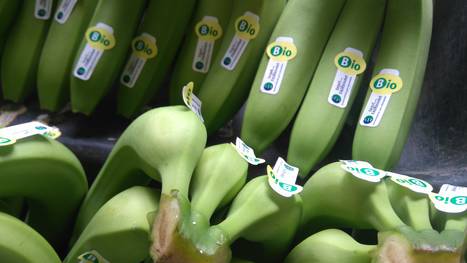Organic certification of bananas

Due to the requirements of organic production in terms of soil quality, water management, climate change mitigation and biodiversity conservation, the organic banana supply is naturally limited. However, demand and production have been growing in recent years, resulting in an 18% increase of the organic banana-cultivated area between 2008 and 20151.
In 2013, the International Federation for Organic Agriculture Movements (IFOAM) estimated that organic banana production represented 850 000 metric tons, almost 1% of the global banana production area. In 2015, the countries that produced most organic bananas were the Dominican Republic (12 000 ha), Ecuador (11 500 ha), the Philippines (6 500 ha), Peru (5 500 ha) and Costa Rica (4 500 ha). Organic banana sales continue to grow worldwide, representing an opportunity for certified producers. Certifying bananas as organic involves assuring compliance with an accredited set of standards, as described below.
Certification is the procedure by which an independent certification body provides written or equivalent assurance that a process or product is conform to the requirements of a specific standard. The certification body is a third party that has no interest in the economic relationship between the supplier and buyer2. The certification process is based on a range of inspection activities which may include continuous on-line inspection, auditing of quality assurance systems and examination of processes and/or finished products.
Organic standards can be:
- Compulsory when developed by governments. Over 90 countries have developed their own regulations on organic production for their territories, and all organic products that are imported in these countries must comply with national organic standards to be labelled as such.
- Voluntary when developed by private organizations. The first voluntary organic certification was developed in 1946 by the Soil Association. Private associations in the United States started to certified organic producers in the 1970s. Organic production materials are tested independently by the Organic Materials Review Institute (OMRI) for the United States and by the Research Institute for Organic Agriculture (FiBL) for Europe. In any case, voluntary certification also includes participatory guarantee systems.

National organic standards in importing countries
Europe, North America and Japan represent 99% of organic banana imports. To sell organic bananas in the main importing countries, producers must comply with local organic standards:
European Union:
- The European organic standard defines the principles and aims of organic production and the rules for organic labelled products.
- 2007 Council Regulation
Japan:
- The Japanese Agricultural Standard (JAS) was created in 2001.
- Standard and technical criteria
United States:
- Following the Organic Foods Production Act of 1990, the United States National Organic Program (NOP) was created in 2000.
- NOP Standards
Canada:
- The Canada Organic Regime (COR) was implemented in 2009.
- Regulation of organic products
- General principles and standard management
- List of permitted substances
There are specific equivalence agreements on organic production standards among certain countries, allowing to trade a product even if the applied standard corresponds to another country’s certifying body. For example, the United States have signed such agreements with Canada, the European Union, Japan, and Taiwan. This allows a product that was produced and certified organic in the United States to be marketed in Japan with the same label, avoiding the costs of applying for another certificate.
Certification process
- The organization or farm adopts organic production practices. To obtain the organic certification, the conversion period requires the testing of soil quality and a rotation plan to rehabilitate resources over 2-3 years. Prohibited substances must not have been used in the production areas for the past three consecutive years.
- The organization or farm must select a certification authority and start the organic certification process paying the corresponding fee.
- The certification authority reviews the documentation of the organization or farm to verify that it complies with the requirements of the standard.
- Subsequently, an auditor carries out an on-site inspection.
- A report of the inspection is prepared, and in case of non-compliances, corrections are made, and the evidence for these shared with the certification authority.
- Once it is verified that the applicant complies with the standard, the certificate can be issued.
- Every year, the auditing company repeats the process of verification and validation of the certificate3.
In the case of a conventional banana plantation, to be able to market the bananas with the organic seal the plantation must comply with the three-year transition period.
- During the first 12 months in the period of conversion, the product cannot be marketed as an organic product.
- After 12 months, it can be indicated on the label of the product that it has been produced under a conversion process to organic production4. However, most importing markets don’t recognize practice.
- From the inspection in the fourth year, a certificate will be issued certifying the organic production and the product can be marketed as such.

References
References
1 ITC. 2016. The State of Sustainable Markets 66pp
2 FAO. 2003. ¿Es la certificación algo para mí?
3 USDA. 2012. Organic Certification of Farms and Businesses Producing Agricultural Products
4 Department for environment, food and rural affairs. 2012. Organic certifications and standards
5 FAO. What are the environmental benefits of organic agriculture?
6 USDA. Benefits of organic certification
7 FAO. 2008. Certification in the value chain for fresh fruits. The example of banana industry
For more information, please refer to Organic farming, Organic banana production in the Dominican Republic, Installation and cultivation of an organic banana plantation in Peru

